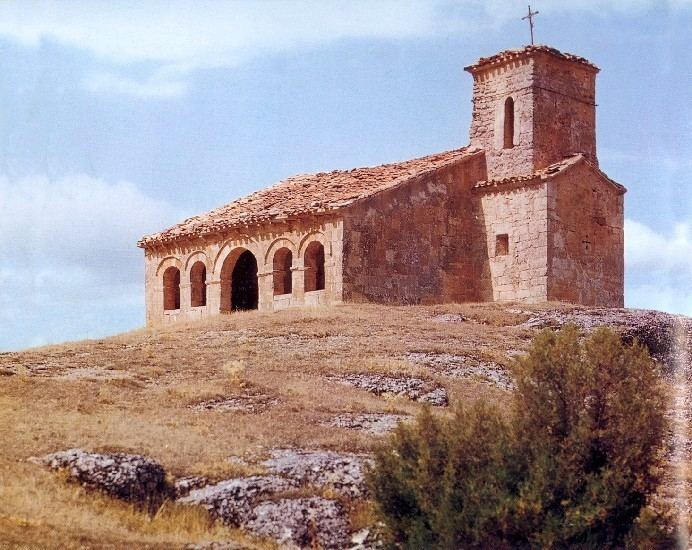The designation Art and Architecture of the Repoblación has been applied in recent years to the works, predominantly architectural, carried out in the Christian kingdoms of northern Spain between the end of the 9th and beginning of the 11th centuries, the period when the region was repopulated, the Repoblación. This encompasses all the buildings which until recently were regarded (and labeled) as Mozarabic, and cataloged following the guidelines set out by Manuel Gómez Moreno. More recently, however, historians have tended to move away from that title because it has been proved that these buildings do not possess the origins that were originally attributed to them.
The religious influences were inevitable given the presence of the Islamic state of the Caliph of Córdoba, which was highly developed culturally, artistically and economically. However, it had long been suggested that the monumental buildings in northern Spain from this period were crafted by the modest groups of Mozarabic immigrants that settled in the areas of repopulation when the living conditions in Muslim al-Andalus became difficult to bear. As stated by professor Isidro Bango Torviso, suggesting that these immigrants were responsible for these buildings would be akin to suggesting that:
when the Duero River Valley was repopulated under the auspices of the Asturian-Leonese kingdom, northerners settlers would have forsaken all their knowledge and experience and submitted themselves to the 'very rich and demonstrated creative capacity' of poor, rural southern immigrants.
The Art and Architecture of the Repoblación is identified as the third subset of the Hispanic Pre-Romanesque period, by the phases that correspond to the Visigothic art and Asturian art. Its architecture is a summary of elements of diverse extraction, irregularly distributed, in such a way that on occasion elements of paleo-Christian, Visigothic or Asturian origin come to predominate, while at other times Muslim characteristics come to the fore.
Some of the identifying characteristics of this Repoblación ecclesiastic architectural style are:
Basilica or centralized plan; sometimes with opposing apses.Main chapel on a rectangular plan on the exterior and ultra-semicircular in the interior.Use of the horseshoe arch of Muslim derivation, somewhat more closed and sloped than the Visigothic.Generalized use of the horseshoe arch doorway or alfiz.Use of the twin and triple windows of Asturian tradition.Roofs composed of segmented vaults, including traditional barrel vaults.Grouped columns forming composite pillars, with Corinthian capitals decorated with stylized elements and cinctures joining the capital to the columns.Walls re-enforced by exterior buttresses.Evolution of rafter ornaments to great lobed offsets that support very pronounced eaves.Decoration similar to the Visigothic based on volutes, swastikas, and vegetable and animal themes forming projecting borders.A great command of the technique in construction, employing principally ashlar by length and width.Absence or sobriety of exterior decoration.Diversity in the floor plans, with small proportions and discontinuous spaces covered by cupolas (groined, segmented, ribbed of horseshoe transept, etc.).The most representative buildings of the genre are:
Monastery of San Miguel de Escalada (Province of León)Hermitage of Santo Tomás de las Ollas (Province of León)Church of Santiago de Peñalba (Province of León)Church of Santa María de Wamba (Province of Valladolid)Church of San Cebrián de Mazote (Province of Valladolid)Monastery of San Román de Hornija (Province of Valladolid)Chapel of San Miguel, Celanova (Ourense)Hermitage of Santa Céntola y Santa Elena de Siero (Province of Burgos)Hermitage of Santa Cecilia de Barriosuso (Province of Burgos)Church of Santa María, Retortillo (Cantabria)Hermitage of San Juan Bautista de Barbadillo del Mercado (Province of Burgos)Church of San Vicente del Valle (Province of Burgos)Tower of Doña Urraca, in Covarrubias (Province of Burgos)Church of Santa María, Lebeña (Cantabria)Hermitage of San Román de Moroso, Arenas de Iguña (Cantabria)Hermitage of San Baudelio de Berlanga, Caltojar (Province of Soria)Monastery of San Juan de la Peña, Jaca (Province of Huesca)Church of San Pedro de Lárrede (Province of Huesca)Pre-romanesque church of the Monastery of Leyre (Navarre)Monastery of San Millán de la Cogolla (La Rioja)Monastery of San Salvador de Tábara (Zamora)Church of Sant Cristòfol, Cabrils (Province of Barcelona)Church of Sant Julià de Boada (Province of Girona)Church of Santa Maria de Matadars (Province of Barcelona)
